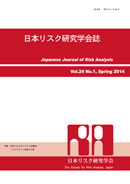Volume 24, Issue 1
Displaying 1-11 of 11 articles from this issue
- |<
- <
- 1
- >
- >|
Editorial
-
Article type: Editorial
2014Volume 24Issue 1 Pages 1-3
Published: June 30, 2014
Released on J-STAGE: July 15, 2014
Download PDF (275K)
Special Issue The Development of the Human Resources for Risk Management by the Academic Society
Reviews
-
Article type: Review
2014Volume 24Issue 1 Pages 5-9
Published: June 30, 2014
Released on J-STAGE: July 15, 2014
Download PDF (602K) -
Article type: Review
2014Volume 24Issue 1 Pages 11-14
Published: June 30, 2014
Released on J-STAGE: July 15, 2014
Download PDF (332K) -
Article type: Review
2014Volume 24Issue 1 Pages 15-20
Published: June 30, 2014
Released on J-STAGE: July 15, 2014
Download PDF (557K)
Reviews
-
Article type: Review
2014Volume 24Issue 1 Pages 21-30
Published: June 30, 2014
Released on J-STAGE: July 15, 2014
Download PDF (496K) -
Article type: Review
2014Volume 24Issue 1 Pages 31-39
Published: June 30, 2014
Released on J-STAGE: July 15, 2014
Download PDF (1237K) -
Article type: Review
2014Volume 24Issue 1 Pages 41-48
Published: June 30, 2014
Released on J-STAGE: July 15, 2014
Download PDF (713K)
Paper
-
Article type: Paper
2014Volume 24Issue 1 Pages 49-59
Published: June 30, 2014
Released on J-STAGE: July 15, 2014
Download PDF (775K)
Report
-
Article type: Report
2014Volume 24Issue 1 Pages 61-66
Published: June 30, 2014
Released on J-STAGE: July 15, 2014
Download PDF (799K)
Book Reviews
-
Article type: Book Review
2014Volume 24Issue 1 Pages 67-68
Published: June 30, 2014
Released on J-STAGE: July 15, 2014
Download PDF (230K) -
Article type: Book Review
2014Volume 24Issue 1 Pages 69-70
Published: June 30, 2014
Released on J-STAGE: July 15, 2014
Download PDF (239K)
- |<
- <
- 1
- >
- >|
